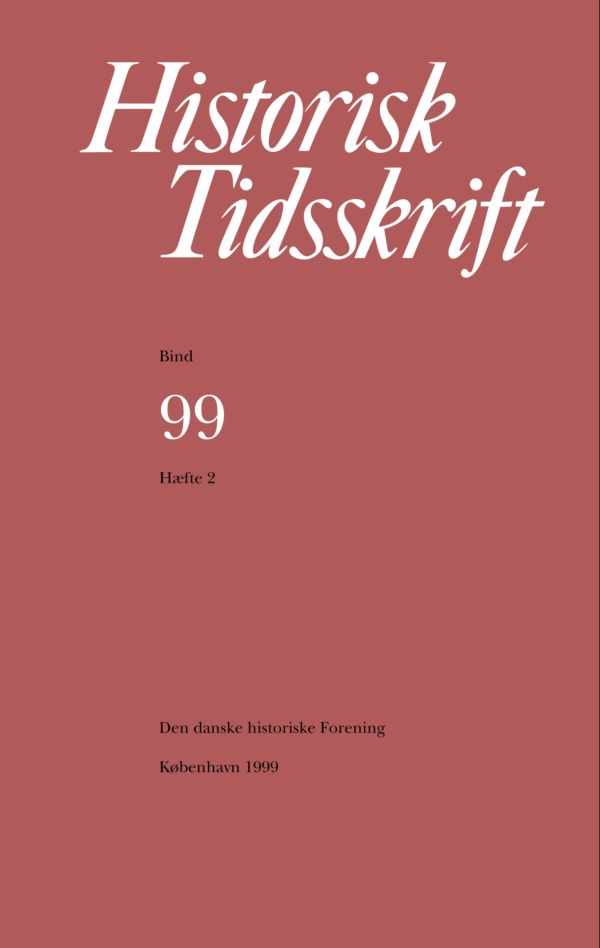Syn for Sagn. Dansk arkæologi og historie i 1800-tallet
Resumé
Danish Archaeology and History in the Nineteenth CenturyThe present study begins with a number of theoretical considerations on the differences between archaeology and historical research, arriving at the position that the frequently postulated difference in the nature of written and material sources is untenable from the traditional viewpoint of source as remnant and report. Nor is it at all tenable from a postmodern conception of source. Moreover, the archaeologist’s and the historian's procedures and methodological problems are so similar that the separation of the disciplines can only be explained in terms of the history of science.An analysis of central historical and archaeological studies from the nineteenth century shows how both disciplines changed character at the beginning of the century within the common context of studies dealing with and concomitantly dependent on Old Norse writings.Within the framework of The Commission for Antiquarian Artifacts and the Aarbøger for Nordisk Oldkyndighed (Yearbook of Norse Antiquarian Studies) and through the pioneering work of C. J. Thomsen and J. J. A. Worsaae, archaeology moved methodologically from distinct dependence on Old Norse writings for the purpose of identifying localities, artifacts and legendary kings to the rejection of these very same texts as contemporaneous with the events and artifacts they portrayed. Artifacts emerged as sources in their own right - and as most reliable evidence of the distant past.The reaction of the historians to this dismissal of the source value of the Norse writings was to turn their attention to modern political history. Historisk Tidsskrift (The Journal of History) became a decisive medium for this reorientation, which was formulated in Christian Molbech's declaration of purpose in the first volume of the journal, and it is made abundantly clear in the articles from this period.Thus arose the conflicting definitions of history among archaeologists and historians. The cultural history of the archaeologists, written on the basis of "speechless" sources created by nameless people, stood opposed to the political history of the historians dealing with great men and central events. Historians such as Johannes Steenstrup and C. Paludan-Müller refused to recognize artifacts as historical sources: according to the historian's definition of the word artifacts had nothing to tell about history. The archaeologists, on the other hand, wished to identify peoples and events of the distant past and to turn them into history by continuing to an extensive degree the earlier practice of using names from the written sources to designate cultures and legendary peoples.Four essential factors left their mark on history and archaeology in the nineteenth century and led to the deep rift that still exists between the disciplines.Firstly, there was the contrast between persons and institutions, The archaeologists were autodidacts, "rebellious" young men who moved in the circles around the National Museum, while the historians were traditional academics from the University of Copenhagen, Many examples can be cited both of written polemics and verbal clashes between practitioners of the two disciplines, and it seems fair to say that the confrontations infected their various conceptions of the disciplines themselves.Secondly, different conceptions of the substance of history created a wide gap between the fields. After archaeologists had been freed themselves from ancient texts, their discipline - according to the historians - had lost its ties to history. The lack of identification of the archaeologists into cultural history, not "real," i.e. political, history. As a result, in many a "History of Denmark" the earliest period is portrayed as a kind of prologue to history - archaeology became pre-history.Thirdly, the conception of source material was central. From an earlier conception of written sources as best and indispensable, archaeologists developed methods which released them from dependence on the written word and incorporated the principle that earlier "speechless" materials were more reliable sources than later written accounts. Historians reached the same conclusion only after Kristian Erslev's distinction at the beginning of the twentieth century between remnant and report. The considerations of the archaeologists on the nature and reliability of sources are so similar to Erslev's that it may be worth examining whether he derived some inspiration from that quarter.The fourth important element was the "national question." While this reinforced the field of political history, it also spurred the archaeologists to continue in their absurd identification of peoples and cultures of the distant past with names mentioned in early Norse sources. Archaeological arguments that could legitimate ancient rights and identify the ancient forbearers of modern nations could serve as powerful instruments in the contemporary political debates on nationalism.The study concludes that the present separation of the disciplines is due to an outmoded conception of history. For the reasons mentioned above, the union of the two disciplines was inconceivable in the nineteenth century, but today it has become ever more apparent that archaology and the study of history have the same purpose and same methods. As a consequence, the future should be marked by a far greater degree of interdisciplinary activity and ever increasing interest in each others' theoretical and methodological concernsTranslated by Michael WolfeDownloads
Publiceret
Citation/Eksport
Nummer
Sektion
Licens
Ophavsret til bidrag i Historisk Tidsskrift tilhører forfatterne og Den danske historiske Forening som udgiver af Historisk Tidsskrift. For illustrationer gælder den ophavsret, som står anført i billedteksten. Ophavsretslovens almindelige bestemmelser gælder, hvilket vil sige, at ophavsretten gælder i 70 år efter forfatterens død. Bidrag i Historisk Tidsskrift må derfor, med forbehold for en ”moving wall” på tre år, frit downloades, læses, gemmes, anvendes og citeres (med kildeangivelse) i privat og videnskabelig sammenhæng, men de må ikke helt eller delvis genudgives af tredjepart, heller ikke i redigeret form, uden tilladelse fra forfatterne og Den danske historiske Forening. Henvendelse skal i så fald rettes til Historisk Tidsskrifts redaktion på histtid@hum.ku.dk.





